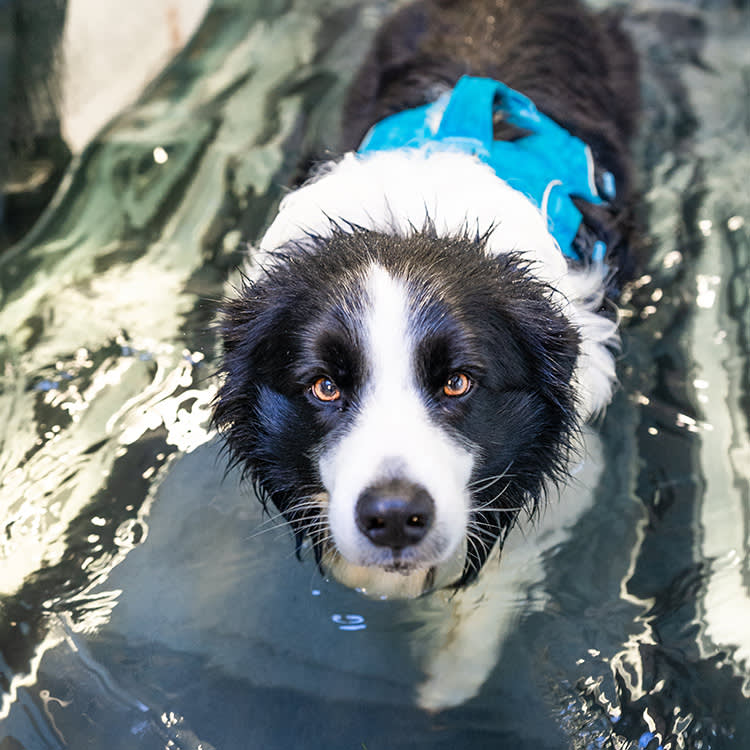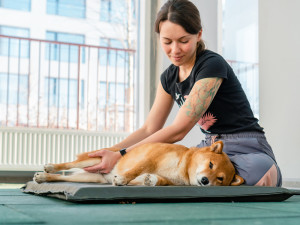Does Your Dog Need Physical Therapy?
Everything you need to know about canine physical rehabilitation.

Share Article
Whether your dog is recovering from an injury or suffering from age-related joint pain, they could potentially benefit from canine physical rehabilitation. Similar to physical therapy for humans, the goal of canine rehab is to increase mobility, reduce pain, and improve your dog's quality of life.
The best way to determine if your dog is a good candidate is to ask your primary veterinarian. If your vet is unfamiliar with canine rehab, do some research to learn more about your options. Though the specialty practice of animal rehabilitation has been around for nearly two decades in some areas of the world, it’s still in its infancy in the United States. Fortunately, the field is rapidly growing.

Save on the litter with color-changing tech that helps you better care for your cat.
How Can Physical Therapy Help Dogs
Rehab can help any dog with a musculoskeletal or neuromuscular problem, from young puppies to seniors. Specifically, canine rehab can help:
• Soft tissue sprains and strains
• Post-operative orthopedic recovery from cruciate ligament repairs such tibial plateau leveling osteotomy (TPLO) and tibial tuberosity advancement (TTA)
• Congenital and degenerative joint disease (dysplasia and osteoarthritis)
• Neurological rehabilitation following spinal decompression surgery (hemilaminectomy)
• Other forms of non-operative neurologic insult, such as fibrocartilaginous embolism (FCE) or spinal cord contusion
Before trying physical therapy with your dog, make sure to clear it with your primary veterinarian. There are underlying medical conditions that can rule out PT as an option, so a medical clearance is essential for your dog's safety.
Your pup’s first visit with a certified canine physical therapist or rehabilitation veterinarian will involve a full body musculoskeletal and neuromuscular evaluation. This specialized, comprehensive, hands-on examination gives the practitioner information needed to develop an individualized treatment plan for your dog’s specific problem(s).
Once the problems have been identified, the practitioner goes to work to address them using a range of approaches including skilled manual therapy techniques (joint and soft tissue mobilization), therapeutic strengthening exercises, range of motion/flexibility exercises, and proprioceptive and balance exercises. Additionally, physical agent modalities — “techniques that produce a response in soft tissue through the use of light, water, temperature, sound, or electricity,” according to the California Board of Physical Therapy — may successfully address pain and accelerate healing.
Finding a Canine Physical Therapist
While physical therapy practices transfer nicely from the human to the canine patient, dog PT has some important specifics that are beyond the entry-level competencies of human physical therapy programs in the U.S. Similarly, not all veterinary schools include rehab as part of their core curriculum. So, finding the right practitioner with the right education is important. Rehab rendered by a certified canine physical therapist assistant (PTA) or registered veterinary technician (RVT) is also an option, but they have to be supervised by a qualified physical therapist or veterinarian with additional training in canine rehabilitation.
States are currently looking at establishing better laws and regulations to govern this particular specialty, which are needed to allow certified and licensed canine physical therapists to practice and to determine competency standards for veterinarians.
In California, for example, these regulations have been hotly debated; efforts are being made to allow properly qualified animal physical therapists to practice on their own premises with a veterinary referral. Historically, the California Veterinary Medical Board wanted to put qualified practitioners under the direct supervision of veterinarians, who may or may not have PT training. A legislative task force has been created to work on more appropriate language.
Every pet parent has a stake in this important discussion. Get involved by letting your legislators know that being able to choose a qualified canine physical therapist is important to you. Those who live in California can find out more at caapt.orgopens in a new tab.
To find a competent and certified practitioner, look for the initials CCRT, CCRP or DACVSMR after the practitioner’s name.
Start your search by visiting these sites:
• American College of Veterinary Sports Medicine and Rehabilitationopens in a new tab
Karen Atlas, PT, MPT, CCRT
Karen Atlas is a licensed physical therapist certified in canine rehabilitation in Santa Barbara, Calif. She is the founder of Atlas Rehabilitation for Canines (ARC). She is dedicated to serving her community with compassionate rehab services and providing educational opportunities to fellow rehab specialists.
Related articles
![Dark-haired woman wearing a brown tank top petting her tan senior dog while under the covers in bed]() opens in a new tab
opens in a new tabHow to Help Dogs With Intervertebral Disc Disease
If your dog has a herniated disc, acupuncture may be the key to relief.
![A senior white dog with arthritis wearing a red collar standing by a large tree in the grass outside]() opens in a new tab
opens in a new tabMedication For Dog Arthritis: Dog Arthritis Pain Management
Hope for dogs with arthritis is on the horizon.
![Happy golden retriever dog on a walk with owner in woodsy yellow and orange fall setting with leaves on the dirt trail.]() opens in a new tab
opens in a new tabHome Remedies for Dog Joint Pain Relief
DIY ways to help your pup cope with the pain.



